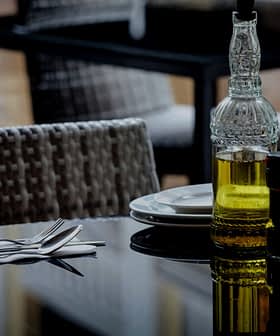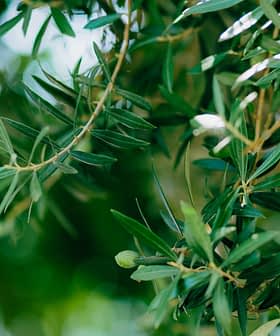In Naples, Pairing Pizza with Local EVOOs
Enzo Coccia, the owner of pizzeria La Notizia in Naples, organized an event dedicated to using extra virgin olive oil on pizza, collaborating with experts to discuss its properties and teach visitors how to taste and detect good quality oil. The event included a tasting of five pizzas paired with different extra virgin olive oils from local producers, showcasing the importance of using high-quality oil to enhance the flavors of the pizza and promote food culture. The event demonstrated the optimal method of adding extra virgin olive oil to a pizza both before and after cooking, depending on the ingredients used, to achieve the best taste and aroma.
For many pizzaiolos the question seems to be as old as the famous “chicken or egg” dilemma: when is it better to add olive oil to your pizza, before or after putting it in the oven?
To answer this question and to dispel other doubts about using extra virgin olive oil on pizza, Enzo Coccia, owner of Naples’ renowned pizzeria La Notizia, organized a full-day event dedicated to the product itself.
Mr. Cocci, who is considered the forerunner of the Neapolitan pizza “renaissance” and has always given the greatest attention to the ingredients he uses to top his pizzas, decided to make his venue a “food culture space,” to explore such high quality products. And it was the perfect place for people to taste and appreciate good food, almost a direct response to a recent Italian TV program’s exposé about unhealthy, badly made pizzas.
No surprise he decided to start with extra virgin, thanks to his collaboration and friendship with the food writer and expert taster Laura Gambacorta and with Raffaele Sacchi, a bon-vivant scientist who teaches on the local faculty of agriculture and who spends most of his time when not researching olive oil making it an everyday staple by usingextra virgin olive oil in home made food when hosting dinners for friends.
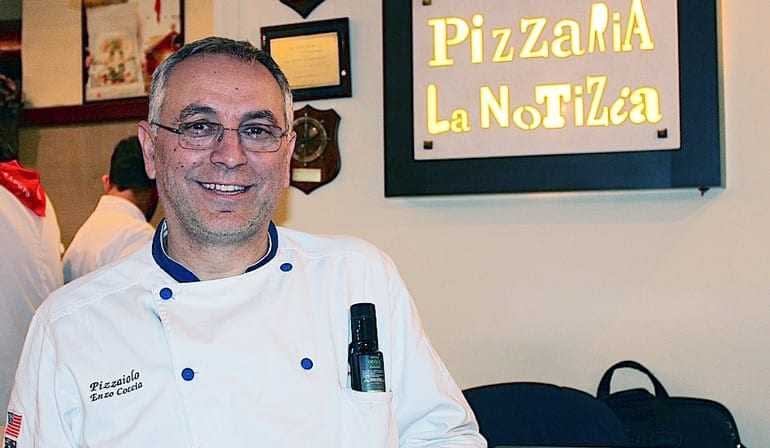
Enzo Coccia, owner of pizzeria La Notizia in Naples
On the morning of the March 2nd, with the help of the extra virgin merchant Riccardo Scarpellini, they invited experts such as Gino Celletti and the Campania panel leader Maria Luisa Ambrosino, to discuss the properties of extra virgin and to teach visitors (journalists, food enthusiasts, chefs and pizzaiolos, which included Jonathan Goldsmith from Chicago’s Spacca Napoli pizzeria) how to taste and detect a good extra virgin olive oil on a pizza as well as a standalone produce. With them were local producers from the Campania region — one of Italy’s richest in olive varieties including one called “Aspirina” (aspirin), as Scarpellini noted.
Even in Italy, the land of olive oil, many people still believe that “acidity” can be tasted and that a pungent olive oil is no good. On the other hand, many pizzaiolos (and chefs) still use cheap, low quality olive oil which can spoil their dishes or pizzas, and the costumer’s experience with no doubt, just to save a few cents. Or, in the best case, one will be probably offered a bottle of extra virgin from Liguria or Tuscany in Naples’ best pizzerias, because owners don’t know enough about their own region’s production. Which is, indeed, excellent and extremely assorted, featuring five different PDOs.
Prof. Sacchi, besides explaining the chemical and nutritional features of EVOO, finally answered the initial question: one should put a little of extra virgin on the raw pizza, to let it merge with other ingredients as they cook in order to establish harmony between them, to soften the pizza and mostly to “activate” the tomatoes’ lycopenes that, in a chemical reaction with extra virgin polyphenols, result in a double antioxidant effect.
But, since the very high temperature of a wooden fire oven removes around half of the extra virgin polyphenols and almost every volatile compounds responsible for the aroma, it is a good practice to pour an extra drizzle of oil as soon as the pizza is out of the oven, to add fruit aromas and taste.
To demonstrate it the pizzeria hosted a special tasting event where five pizzas created by Enzo Coccia where matched with just as many extra virgin olive oils by the invited producers.
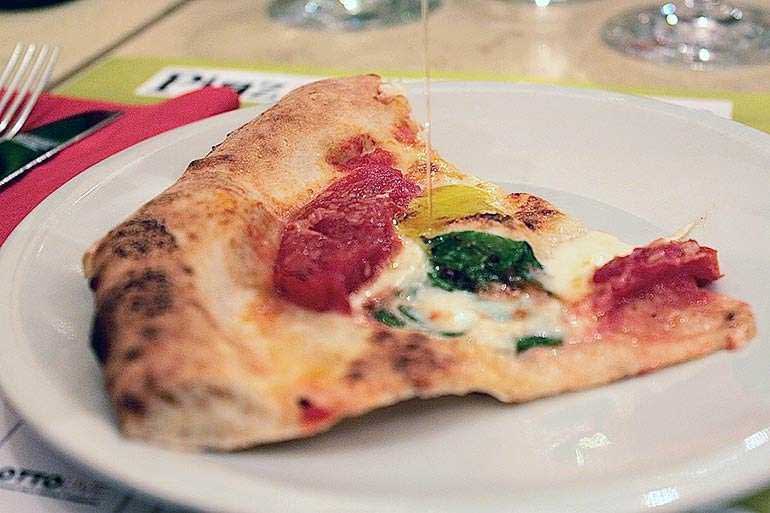
Pizza with pacchetelle tomatoes with Le Tore organic extra virgin
The first one was a pizza with fiordilatte cheese and “pacchetelle” tomatoes (the traditional Vesuvius Piennolo tomatoes cut into halves and preserved in glass jars) paired with Le Tore organic extra virgin. The oil — a blend of Carpellese, Frantoio and a good 60 percent of the local variety Minucciola — was a medium, green olive fruity with notes of grass, almond and walnut and with a distinctive bitter taste slightly overpowering the pungency, that went perfectly with the simple but rich pizza.
Incredibly, it was a two-year-old oil, since the farm and country house located in the heavenly Penisola Sorrentina didn’t produce any oil this year following the difficult season and a summer hailstorm, and owner Vittoria Brancaccio had already sold out last year’s production.
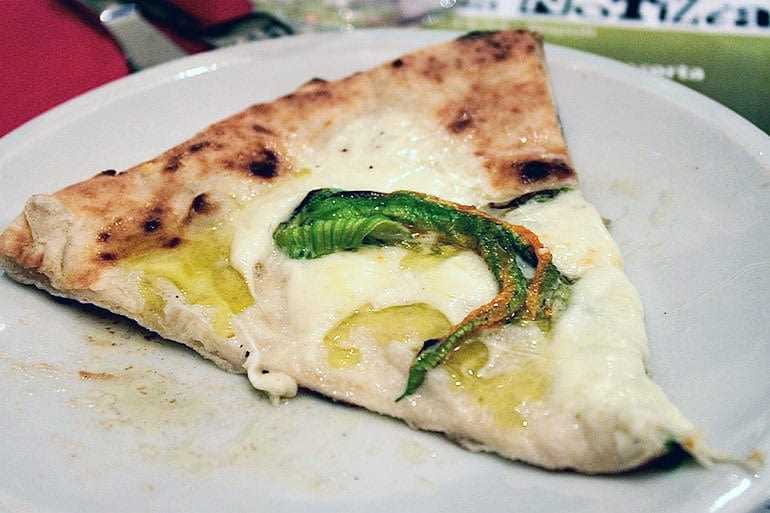
Pizza with buffalo mozzarella, zucchini flowers and pecorino cheese, came with the excellent PDO Colline Salernitane extra virgin Diesis from Frantoio Torretta
The second pizza, with buffalo mozzarella, zucchini flowers and pecorino cheese, came with the excellent PDO Colline Salernitane extra virgin Diesis from Frantoio Torretta run by Maria Provenza in Cilento, the southern area of Campania. This was a medium fruity with notes of green olive and a neat artichoke leaf smell that was confirmed by the tasting and worked incredibly well with the pizza.
The third pizza showed the creative side of Enzo Coccia and the incredible Campania food heritage featuring raw endive, black olives, local medium-matured sausage and yellow tomatoes. To match and balance those unusual flavors, the chosen oil was the fantastic pitted Carpellese monocultivar from Madonna dell’Olivo. The small farm in Cilento is managed with obsessive care by Antonino Mennella, which this year was not able to produce three out of four of his oils and was not completely satisfied with the remaining one either, even though we really appreciated it for its great elegance and its charming notes of bitter almond and herbs, both alone and onto the luxurious pizza.
The “all-time-classic” Margherita made with San Marzano PDO tomatoes was paired to Frantoio Romano’s Ortice single variety extra virgin made in the Sannio region which, with its notes of herbs and ripe tomato, was simply perfect with the pizza.
Finally, the Marinara with San Marzano PDO tomatoes — one of Enzo Coccia’s signature pizzas — was the only exception to Sacchi’s suggestion to add oil after cooking as well as before, but not without a reason: the dairy-free pizza is seasoned with tomato (which “links” with the oil at high temperature) and with garlic and oregano which give the pizza a full range of aromatic scents and flavors, so that the extra virgin. made by the Capolino Perlingieri farm, couldn’t have added anything further.
The evening was a clever and enjoyable way to spread the culture of local extra virgin olive oils and great food, thanks to Coccia’s pizzas and to the talented experts who kept things simple.
As Raffaele Sacchi said, despite all his advanced knowledge, the best way to define a good extra virgin olive oil is still the one he heard from a child at a school he recently visited: “a good oil tastes of living olives, and a bad one tastes of dead olives.”


